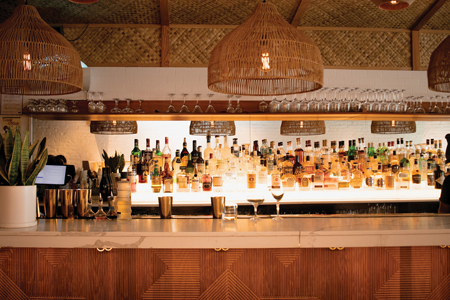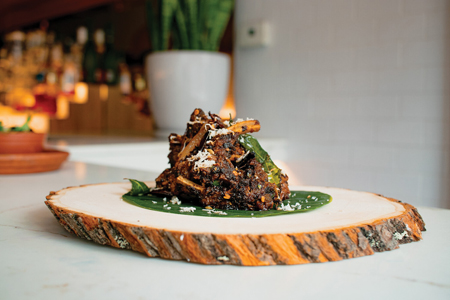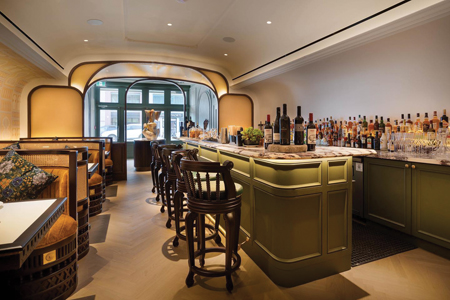Khabar Magazine. Dec 2023 print issue.
Indian restaurants sorely failed to make a mark in the recently launched Michelin Guide for Atlanta. Here are six things they can do to step up their chances to get the highly coveted Michelin star.
October was somewhat of a milestone in the annals of the dining scene in Atlanta. It was when the prestigious Michelin Guide launched in Atlanta, making it the seventh destination in the United States and among 40 worldwide to be awarded the Guide. Originally started in Paris in 1926, the Guide has become a reference Bible for foodies and an Oscarequivalent for restauranteurs. Winning a Michelin star has become the epitome of a chef’s career.
At an invitation-only celebration at Georgia State University’s Rialto Center for the Arts, chefs, media, and influencers eagerly gathered to hear which restaurants would be included in the inaugural Atlanta Michelin list. We took photos with the mascot Bib, sipped on champagne and Chai Box tea, and tasted international bites from local chefs and caterers. As many as 45 restaurants across 23 cuisines were recognized by the Guide for their superb food, service, and talent. But there was only one Indian restaurant—Chai Pani in Decatur—that earned a recommendation for its “colorful artwork and fried okra.”


The ambience as well as the food is full of flair at Semma, a Michelin star restaurant in New York City.
Over the past few years, chefs of Indian origin have changed the perception of Indian cuisine and gotten on several honorary lists such as The New York Times Best Restaurants, James Beard Foundation, The World’s 50 Best, etc. but their presence in Atlanta has consistently lagged behind. As a South Asian dining critic, it was heartbreaking but understandable to see the lack of Indian restaurants in the Michelin Guide for Atlanta.
There are many reasons for this poor showing. Yes, you can find a decent dosa and satisfying chaat around here, but there’s really no fine dining establishment serving innovative Indian cuisine comparable to what you can get in other metropolitan cities like New York City, Los Angeles, Washington DC, San Francisco, Chicago, and Miami.
So, what can Indian restaurants in Atlanta do—not just for Michelin stars but also for earning a reputation as a destination restaurant that elevates the city’s dining scene? As someone who has dined at Michelinstarred restaurants around the world, I would like to suggest the following.
Put the face of a celebrated chef
Many of the most celebrated restaurants are chef-driven—which is missing in Indian restaurants in metro Atlanta, many of which are entirely run by non-Indian hourly workers who simply churn out mechanical recipes.
Award-winning restaurants are often backed by personalities that have a skin in the game such as a partnership in the business and a passion to implement their menu and style. They are often prestigious culinary school graduates, cookbook authors, television stars, or have some such claim-to-fame as a chef. Unfortunately, the only restaurant in the Atlanta area affiliated with such a personality is Yellow Chilli in Johns Creek. However, this restaurant from Master Chef Sanjeev Kapoor has failed to live up to his pedigree, perhaps because he has been largely absent in crafting it to his standards.
On the flipside, Chef Vikas Khanna’s Manhattanbased Junoon became the first Indian cuisine restaurant to receive Michelin stars for six consecutive years. It showcases six- to eight-course tasting menus that actually live up to the impeccable standards of Khanna, who is arguably one of the most celebrated chefs from India.
Go regional
Today, people are well-traveled. They watch television shows, read cookbooks, and watch cooking videos on YouTube. Both Indian and Western diners are tired of the cookie-cutter menus lumped in just two broad categories: “north and south Indian.” They are looking for new authentic dishes that tell a story about the cuisine. Indian food is packed with flavors and complexity. It is also hyper-local with so many delicious regional offerings.
Indian restaurants in Atlanta tend to play it safe. Restaurants in other big cities go beyond the trite and focus on the chef’s origins and homegrown flavors. Earlier this year, I was blown away by the interesting combination of ingredients and flavors at Semma, a Michelin-star restaurant in West Village, New York City, where Chef Vijay Kumar uncompromisingly presented flavors of Madurai and Tamil Nadu in ways I had not seen before. After tasting the tender lobster tail in coconut milk moilee, flaky buttery parotta, and spicy gunpowder dosa, I wanted to make another reservation right away!
Indian restaurants in Atlanta also need to think of incorporating bold ingredients into their menus— which is not novel as it is being done across the world. You can find nathai pirattal (peconic snails), tandoori octopus, Goanese oxtail, jackfruit curry, and Dungeness crab masala at many famous Indian restaurants.
Source better
One of the common threads across all new awardwinning restaurants is the use of locally sourced, fresh, and quality ingredients. It is no surprise that better ingredients result in better tasting food. Chefs and restaurants that make a conscious effort to work with producers and highlight seasonal local meat, seafood, and produce, are perceived as ones who “care” about their cooking. At Adrak Yorkville in Toronto, you will find Nova Scotia lobster and Atlantic halibut; and at Ghee (named Michelin Bib Gourmand) in Miami, chef Niven Patel makes pakoras using taro leaves and curries with asparagus, kale, and calabaza from his own two-acre farm called Rancho Patel.
Aesthetics and ambience matter
Diners today are looking for an emotional connection with the surroundings and for lively, upbeat ambiance where it’s not about “just the food.” They want to walk in and hear the music, visualize a fun atmosphere, and even take some Instagrammable shots before sitting down. At Adrak, the hand-carved wood and wicker furniture, subdued colors, and refined artwork instantly transported me to a houseboat in Kerala. At New York’s DhaMaKa, I felt I was at an explosive Bollywood dance party with exciting energy and lively food.
Throughout the meal, there should also be beautifully presented cocktails, a selection of fine wines, and elevated food that is worth photographing with one’s senses and smartphones. There’s no need to have white tablecloths or an ultra-luxe menu but, really, smaller plated dishes with many elements of colors and textures make the restaurant more welcoming.

The interior design at Adrak Yorksville, “instantly transported me to a houseboat in Kerala,” says the author, highlighting the importance of the décor and ambience for the overall dining experience. (Photo: https://www.facebook.com/ adrakyorkville)
Get media savvy
Now that the Michelin Guide has come to Atlanta, it will draw the attention of travelers from all around the world who will look at the destination as a culinaryrich city. Naturally, the media plays a significant role in influencing diners’ perceptions. They read reviews, rankings, and social media posts to find out about the “hottest spots.” Now is the time for Indian restaurants to up their media spending and highlight their unique offerings. Even judges often refer to local reviews and writeups before deciding on where to eat.
It is increasingly worth investing in such a sophisticated media and marketing strategy because people are willing to pay for good food and experiences. Career chefs, knowledgeable staff, quality ingredients, and good locations cost more, so it’s natural that such restaurants will have a higher price point. Judges are typically not price conscious and some of the most expensive restaurants in Atlanta are the ones that got a Michelin star. Lazy Betty, which was one of them, charges $205 per person+ drinks for their tasting menu.
Be ambitious
The Michelin Guide’s selection criteria for restaurants include product quality, mastery of culinary techniques and flavors, reflection of the chef’s persona within the dining experience, and harmonious blend of flavors. Michelin inspectors are trained eaters who go around the world searching for consistency across multiple visits to ensure each of the criteria is met. The star ratings and restaurant selections undergo annual updates and those who fail to maintain their standards are omitted from the Guide. To earn a Michelin rank, you have to really want it and work towards it!
~ Written for and published by Khabar Magazine. All rights reserved.